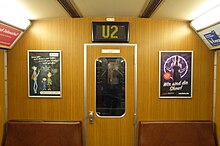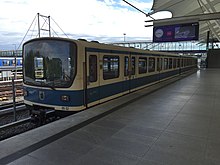MVG series B
| Munich subway series B |
|
|---|---|
| Number: | 63 double railcars (126 single cars) |
| Manufacturer: | DWA , MAN , MBB |
| Year of construction (s): | 1981-1995 |
| Axis formula : | B'B '+ B'B' |
| Gauge : | 1435 mm ( standard gauge ) |
| Length over coupling: | 37,550 mm |
| Height: | 3,550 mm |
| Width: | 2,900 mm |
| Trunnion Distance: | 12,000 mm |
| Bogie axle base: | 2,100 mm |
| Empty mass: | 56.0–58.5 t (depending on type) |
| Top speed: | 80 km / h |
| Hourly output : | 4 × 195 kW = 780 kW |
| Motor type: |
Three-phase asynchronous B1.4: 1 TB 2027 B2.7 / B2.8: BSAI 5943 / 6D |
| Power system : | 750 V DC |
| Seats: | 98 |
| Standing room: | 192 |
The B series is a type of vehicle on the Munich subway . Slightly different versions of the cars delivered from the late 1980s to the mid-1990s are also used on the Nuremberg subway , but under the name DT2 .
The vehicles were mainly needed for the numerous network expansions, a total of 63 double multiple units were built for the Bavarian capital.
development
| Type | Numbers | number | Years of construction |
|---|---|---|---|
| B1.4 | 494-499 | 6th | 1981 |
| B2.7 | 501-535 | 35 | 1987 |
| B2.8 | 551-572 | 22nd | 1994 |
At the end of the 1970s, due to the imminent expansion of the route network, one had to think about a successor to the tried and tested Type A, which was now technically obsolete and therefore no longer economically viable. In 1981 MBB from Donauwörth delivered the six prototypes (two long trains) 494 to 499 of the B1.4 series. After these trains had been tested for around seven years, delivery of the series vehicles (types B2.7, B2.8) did not begin until 1988, which were manufactured by MBB as well as by MAN and, after reunification, by DWA in Bautzen . Since the prototypes were initially unsuccessful, Type A cars have been purchased again in the meantime .
In 1994, the 500th single car of the Munich underground was put into operation with the 565 double multiple unit. It was financed by the city of Garching together with two other double railcars (566 and 567) and therefore bears the Garching coat of arms on one side of the car instead of the one from Munich .
A driver's cab and part of the following car of the prototype 497 are on display in the MVG Museum in Ständerstrasse.
Structure and technology
Externally, the B-cars are very similar to their predecessors in the A series , so the car body dimensions are very similar. The only difference is that the length of a single car is 18,775 mm and a double railcar via coupling is 37,550 mm. The arrangement of doors and windows as well as the distribution of seats and the lightweight aluminum construction are also identical .
The biggest differences are in the front face, which has a large windscreen instead of three small ones, and in the electrical part of the vehicles. Instead of the old fall-leaf indicators , the trains of the B2.8 series have built-in matrix displays , whereas the B2.7 series still has fall-leaf indicators.
The longitudinal three-phase asynchronous motors are continuously controlled via DC choppers and inverters . The braking energy can be fed back into the network. The electrical equipment is completely installed under the passenger compartment.
Due to the different equipment, the A and B cars can be coupled mechanically, but not electrically. The same problem initially existed between the prototypes and the production vehicles, but after the former had been converted by 1995, the two types were compatible with each other.
Type B with Syntegra bogie
At the beginning of 2006, the Siemens Transportation division bought the B train No. 498 from the Munich municipal utilities in order to use it as a test and demonstration vehicle for the new “ Syntegra ” powered chassis .
In the last few years, Siemens had developed this new engine running gear concept, which is driven by a gearless three-phase direct drive based on a permanent magnet synchronous motor. In this new type of engine, the drive has been installed “around the wheel axle”. It is the first power unit of its kind in the world that has neither a gear nor a fully-fledged mechanical brake. This makes the motor particularly smooth, lighter, and quiet, and the available acceleration / braking torque is almost completely independent of the speed. Japanese and French companies are also pursuing similar approaches in drive technology. A direct drive from Toshiba , but not designed as an integral part of the chassis, is located in a local train / metro in Tokyo. Alstom offers synchronous drive technology in the AGV high-speed train , but not as a direct drive, but conventionally with a gear stage.
The life cycle costs (LCC) could be further reduced due to the higher efficiency, the lower wear, the higher availability thanks to redundancy and the improved bogie . A visible feature is the significantly smaller center distance and comparatively small wheels due to the lack of a gearbox.
As part of the test program, both bogies and the entire drive and control technology under one of the two cars (7498) were replaced by the Syntegra type. Electronic components, power regulators and mechanical components had to be replaced. Measurement electronics, sensors and recording devices were installed for evaluation and documentation. The interior has remained largely the same and only differs in the distant billboards. The other part of the train unit 6498 has remained largely the same and serves as a comparison car.
Since then, this vehicle, which has a Siemens advertisement on the outside, has also been seen more often in the Fröttmaning technical base. The first measurement runs took place in the Siemens test center Wegberg-Wildenrath in North Rhine-Westphalia , the commissioning on site then within the depot Munich North on an approx. 2000 meter long parallel route to the U6 line . This was followed by measurement and approval trips across the entire Munich subway network . The vehicle has a full approval according to BOStrab and has been in passenger service on the U6 line since August 12, 2008 as a medium vehicle in a long train (P6). The train also runs on other lines as required.
See also
- BVG series F - Comparable double multiple unit of the Berlin U-Bahn (F84, F87)
literature
- Martin Pabst: U- and S-Bahn vehicles in Germany . 1st edition, GeraMond Verlag, Munich 2000, ISBN 3-932785-18-5
- Wolfgang Pischek, Holger Junghardt: The Munich U-Bahn - underground through the Bavarian capital . Munich 2002 (2nd edition), ISBN 3-7654-7194-1














